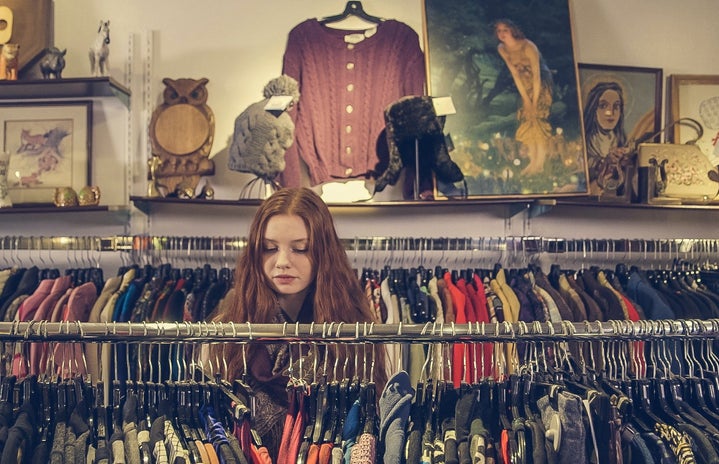This is Sustainability in Conversation; a series where I talk to people about their individual experiences of sustainability. In a world where the media is a continual onslaught of negative news and general dreariness, I wanted to talk to the environmentalists, the business owners, the experts, the craftspeople and everyone else with a love for sustainability – about what they’re personally doing to help protect our beautiful planet. In doing so, I hope to maybe remind myself (and hopefully you) that there are some pretty wonderful people out there, doing some amazing good.
With so much in the media at the moment about so-called sustainable and ethical fashion, you might be feeling pretty overwhelmed about which consumer decisions you should be making. I sat down (over FaceTime, naturally) to talk with Beatriz Gyuricza, a Fashion Design student at Nottingham Trent University, to discuss some key issues and considerations to bear in mind when we talk about and practise sustainable fashion. So, here’s a whistle stop tour on the growing sustainable fashion movement, and the part you can play in it.
It’s a term that’s floating around quite a lot at the moment, but what is fast fashion? In many ways it’s hard to define, especially when so-called fast fashion brands are often doing so much to distract from their fast fashion side. I definitely spent a lot of time defending H&M because of their “Conscious” collection and their Close The Loop initiative, where they give out £5 vouchers in exchange for used clothing items which they recycle. Cambridge Dictionary defines fast fashion as ”clothes that are made and sold cheaply, so that people can buy new clothes often.” At face value, that doesn’t seem like the worst thing in the world. Ensuring people can affordably buy clothes when they need them? In principle, that’s an excellent idea; unfortunately, with consumerist culture always telling us to buy more, the fast fashion industry’s impact on the environment has spiralled a little out of control.
There’s recently been an argument put forward that fast fashion can be considered sustainable if we treat the items like “slow fashion” items (clothing from smaller collections, released on a few occasions throughout the year). Beatriz gave a different perspective on this ideology, however:
“Like I mentioned before, it’s a lot more complicated than that, but I do think that it’s like with everything that we do – we produce way more than we actually need, just in case… I remember I worked at New Look and I wanted to know what happened to the clothes that don’t get sold and they literally just have kilos and kilos of clothes to donate to charity at the end of each season. There was a scandal with certain clothing shops where they would chop up clothes before they put them in the bin so people couldn’t use them.” Yikes. It’s true. Maybe these companies really don’t care about their impact, despite all their virtue signalling to tell us otherwise?
So what is sustainable fashion really about? Beatriz said that in many ways, it’s pretty unachievable as a consumer alone. “It’s difficult because there are so many aspects that go into it that we as a consumer can’t really do anything about, like how certain dyeing processes are really harmful for the environment and things like that.” The list of issues with fast fashion does seem never-ending. Beatriz says that maybe the way forward is changing how we look at fashion: “Sustainable fashion, to me, means the part you can play in it. It’s about changing the capitalist mindset.” Now, that’s a pretty big ask. Our society is structured around the “rise-and-grind” lifestyle; our lives are built upon capitalist principles. We get bored of an item of clothing? Fine. There are a hundred-and-one shops on the high street ready to lift cash right of your wallet in exchange for a fairly mediocre top that’s going to bobble after one wash.
So where should we go from here? What’s the secret to escaping the capitalist mindset? Well, Beatriz suggests a couple of sustainable rules of thumb we can start applying to how we see fashion, and here they are in no particular order:
- It’s a wonderful life. “You have to expect that at some point [an item of clothing] will end up in landfill”. That’s the harsh reality of so much that we purchase. So you’ve got to give your clothes a really wonderful life, bearing in mind that they don’t (and won’t!) last forever. Buy clothes with the intention of loving them for years and create a privileged spot in your wardrobe for them. Not to mention if you decrease how much stuff you buy, you’re going to start appreciating every item that little bit more, and you’ll have to “think outside the box just a little bit” as Beatriz puts it. That shirt might have lost its excitement factor when paired with jeans, but it could be the perfect base for a whole other outfit when paired with a pinafore or pair of dungarees! We’ve got to look after our clothes properly, which can even mean doing something as simple (and economically efficient) as doing your colours wash on a colder cycle. If we can learn to do all that, why would we need to keep buying more and more stuff (other than when you’ve lovingly worn your clothes into disrepair beyond recognition)? We’ve got to learn to love every item in our closets. And we’ve got to stop choosing fast fashion, and start “using what’s mostly already available to [us], because there’s so much.”
- Take a picture, it’ll last longer. Beatriz suggests a good practice to integrate into the way you shop is: when something catches your eye, take a picture of it, and “keep it there for inspiration.” By the time you come back to it, you might’ve already changed your mind, or you’re much more likely to spot features that start to irritate you (a slightly askew button, a buckle that’s going to catch on your jacket cuffs, a zip that makes the fit just that little bit too tight. You get the picture). Maybe you still love it when you come back to it, and then you know it’s worth it!
- Fake it ‘til you make it. Much of Beatriz’s contemporary fashion design and manufacture skills were born from just experimenting and trying out DIYs. Even if it’s just learning to stitch up a hole in your trouser leg (something I, myself, am appalling at) or tie-dyeing that t-shirt that never sees the light of day, it’ll hopefully mean that you get much more wear out of your wardrobe.
- You’ve got to have a type. When you go shopping, whether it’s fast fashion, charity/thrift shopping or even just scrolling through Depop, go forth with intention. If you just go to shop, “you’re just gonna pick up everything that looks slightly interesting to you, and then it will just sit in your wardrobe.” While sometimes a little mindless retail therapy feels necessary, it’s not only going to burn a hole in your wallet for a pretty meagre payoff, it’s also not great for the environment, especially when done on a regular basis.
- If the shoe fits… And if it doesn’t, don’t buy into it! Some approaches to changing your fashion consumption are simply not going to work for you, and that’s okay. As Beatriz puts it, “you have to figure out what it is that works in your life and isn’t going to disrupt it to the point where you’re unhappy.” In the name of sustainability, you might have to give up a few things, but that doesn’t mean you have to give up everything, because what kind of life is that? It’s all about finding your balance.
- Stick it to the man. Perhaps the most important rule of them all, with much less change to your shopping and fashion habits and way more change to your mindset: screw it. This might seem a little contradictory to a lot of what I’ve talked about, but it really is perhaps the most important part. Beatriz admitted “at times I have to remind myself that I cannot carry the weight of the responsibility [of all consumerist decisions].” That is definitely something we – consumers, environmentalists, the general public with little control over an industry that “emits more carbon than international flights and maritime shipping combined” – need to bear in mind. We cannot “carry the weight” of corporate and conglomerate indifference and apathy. It’s just not our job. Yes, there are things we can all do to be more sustainable, but ultimately we are all just individuals trying to protect our planet. And that is a huge burden to put on ourselves and our mental health. As Beatriz puts it: “We just need to help. We need to have more empathy and more compassion.” At the end of the day, isn’t that really all we can ask for?
Image courtesy of @chickbea
Beatriz spent a lot of time watching her Vovó (her grandmother) at her sewing machine; her Vovó taught her how to make dresses for dolls She cited this as one of the reasons why she loves fashion now, saying that much of her appreciation came from understanding and appreciating fashion as a craft and learning how much effort goes into creating even just one item of clothing. This philosophy is now an important feature of her environmentalism, so in this way, learning fashion as a craft has meant that she can create items that she loves and appreciates, whilst protecting the planet.
Beatriz makes custom items on commission, including jewellery, reworked vintage/charity shop items, and beautiful one-of-a-kind knitted pieces. You can check her out via her Instagram or via her Depop.
Words By: Gina Moran
Edited By: Laura Murphy



